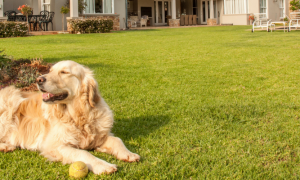Guest Post by HomeAdvisor
Congratulations! You’re considering getting a pet, or you’re about to bring a new furry friend home to join the family. This is an exciting moment. Of course, it also requires some preparation — part of which includes readying your home for the new addition. Here’s how to prepare your home for new pets:
Kitchens and Bathrooms
Install childproof locks on your cabinets so your new pet can’t open them and get to potentially dangerous items. Professional installation will cost about $460.
Put anything your pet can reach — medicine, chemicals, etc. — on a high shelf.
Invest in covered trash bins that can’t be knocked over easily.
Keep food and other edibles out of reach.
Living Room
Hide wires from TVs, stereos and other electronics to prevent animals from chewing on them and shocking themselves.
Hide any small items your pet could chew on or knock over and break.
Move potentially poisonous plants outside, or place them out of reach.
Give them something comfy to lay on, whether it’s a bed on the floor or a blanket on the furniture.
Put machine-washable slipcovers on your furniture.
Certain types of furniture are easier to clean than others; have the right cleaning materials on hand for messes and accidents.

Bedroom
Put clothes and shoes in closets — and close the door so your pet can’t get to them.
Keep any medications or cosmetic items in drawers.
Any household cleaners that you keep in the master bathroom need to be well-hidden or kept behind childproof locks.
Secure garbage cans with lids or store them underneath cabinets.
Outside
Keep your animals away from pools or ponds to avoid drowning.
Check your fence for any holes to ensure your pet can’t escape from the yard.
Designate a certain part of the yard as your pet’s bathroom. Keeping it to the same spot helps prevent damage to your bushes or grass.
Move hazardous chemicals and sharp objects to your garage — and keep your pet away from the area.

Other General Areas to Consider:
Windows
If you can, replace vertical blinds and window treatments that incorporate draping tassels or cords; these could become choking or strangulation hazards.
Avoid using mini-blinds in your home; pets frequently bend and break them when they’re curious and want to see outside.
Walls
Semi-gloss paint is washable and easy to clean.
Vinyl-backed wallpaper is also easy to clean; you might consider this option in rooms in which your dog may be training.
Floors
Area rugs are easier to keep clean than carpeting. If you have carpeting, use enzymatic cleaner to eliminate urine and poop smells.
Tile and linoleum flooring are easy for handling pet accidents. Keep this in mind when deciding where to put your pets during the day.
Make sure your hardwood floors are sealed before your pets walk on them.
For more tips on how to prepare a home for pets, check out this article from Adopt a Pet on pet proofing your home.
Andrea Davis is the editor at HomeAdvisor, which connects homeowners with home improvement professionals in their area for free. Connect with Andrea on Google+







Great article, have shared online with social media pet industry channels. Has CB written anything about How to find the right house for your pets ? Your interest in the pet industry is well founded and appreciated. I tweeted CB in a retweet of this article. Thanks
Very nice information, really appreciated . Thanks for Sharing Lindsay.